The term Orthotics can refer to almost any device which is worn inside a shoe. There are two very different types of orthotics. The first is a non-prescription orthotics or arch-support. The second is a custom prescription orthotic, which is a prescription only, precision medical device. There is often confusion between the two devices because they can look very similar.
What Is Custom Prescription Orthotics?
Some people call them arch supports but they are much more! Prescription orthoses (often called orthotics) are precision balanced medical devices worn in your shoes to allow the feet and lower extremities to function properly and help eliminate pain and deformity caused by improper function. They are individually designed to fit your feet and act to restore normal biomechanical function of the lower extremities.

Functional Foot Orthothes are customs medical devices geared to treat foot or biomechanical problem. It can also be customized to fit in a variety of footwear such as runners, dress shoes, soccer cleats, ski boots…etc.
Orthotics are used as a conservative approach to many foot problems or as a method of control after certain types of foot surgery. Studies demonstrate their use is a highly successful, practical treatment form.
Who needs orthotics?
Most foot pain is the result of a faulty relationship between the bones and muscles of the foot. Even the slightest misalignment can result in significant discomfort. This abnormal function can result in problems such as bunions, hammer toes, arch and heel pain, corns and calluses, knee pain…even back pain.
The function of custom orthoses is much more than an arch support. Orthoses realign the structures of the foot and leg to prevent bone malalignment as well as muscle, tendon, and ligament fatigue. They are often used after surgery to help stop the recurrence of foot deformities. They are used to maintain the surgical repair and prevent further degeneration of the foot.
If you experience any of the following complaints, you may be a candidate for prescription foot orthotics:
- Heel pain,
- Arch pain,
- Flat feet,
- Ball of the foot pain,
- Tired, achy feet,
- Neuromas,
- Bunions,
- Arthritic conditions,
- Tendonitis Calluses,
- Chronic ankle sprains,
- Lack of stability,
- Limb length discrepancy,
- Knee, hip, or back pain.
What is Involved in Producing Your Orthotics?
1. Biomechanical Examination
Biomechanical Examination is an extensive examination of the function of your lower extremities helps us prescribe the correct orthotic to address your specific problem.
2. Gait Analysis
There are 4 stages in each step you take: heel-strike, mid-stance, toe off, and swing.
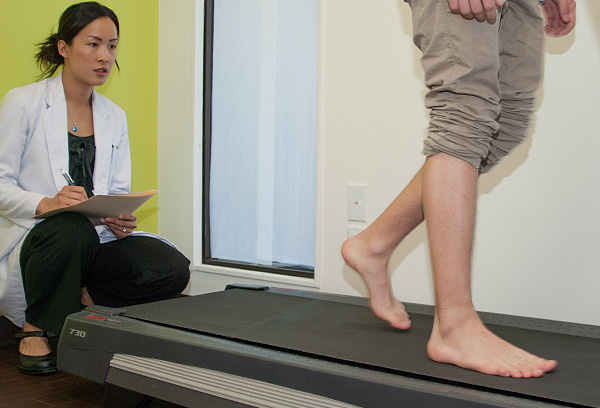
Dr. Alice Wang performing a gait analysis on a pediatric patient.
The doctor will watch you walk to evaluate for any gait imbalances, muscle weakness, limited range of motion problems, and asymmetry in order to determine treatment plan and orthotic prescription. Some of the mechanisms observed during this type of examination are:
- Supination and pronation in your feet.
- Motion of your big toe joint and lesser toes.
- Arch collapse or instability Rotation of the legs, hips, and shoulders.
- Arm swing Position of the shoulder, knees, and feet.
3. Casting
For optimum orthotic function, orthoses must be made from a 3-dimensional mold of your foot. The only method of producing this mold is to take a non-weighbearing cast of your feet while they are held in the ideal position determined by the doctor.

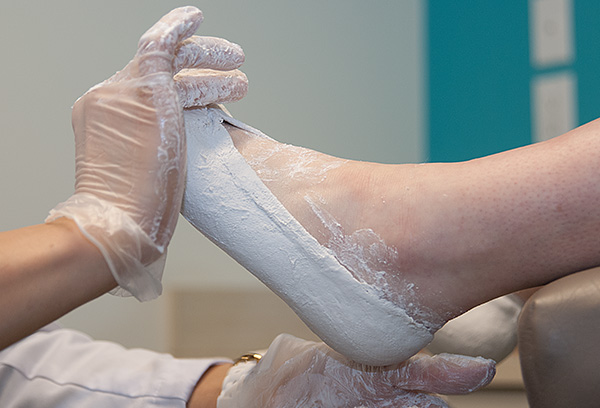
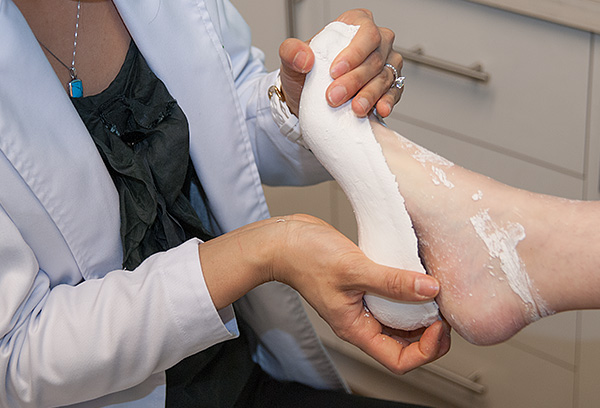
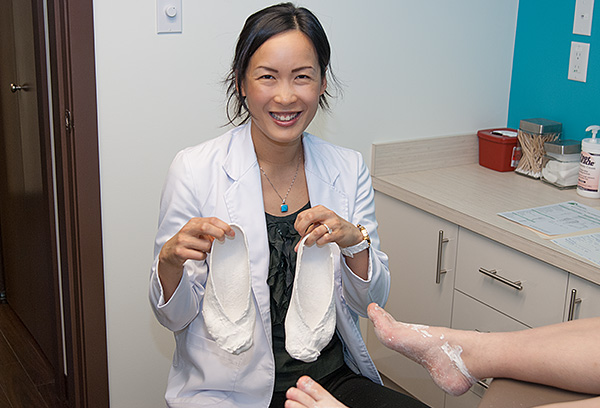
Custom orthotics are made from molds taken from plaster of Paris.
4. Orthotic Prescription and Shoe Selection
The doctor will fill out the orthotic prescription based on your symptoms, biomechanical exam, and gait analysis. Time is taken to discuss proper shoe gear base on the work and activities you do. The doctor will spend some time going over the shoes you wear regularly and determine the final design of the orthotics to fit into these shoes. If you have poor choices of shoes, the doctor will give you recommendations and help you find the appropriate, comfortable, and fashionable shoes for you. The goal of orthotics is to give you proper support and eliminate pain. However, finding a good shoe is just as important!
5. Laboratory Production
Your casts then are sent to a laboratory for production of your orthotics. The lab technicians will follow the doctor’s detailed prescription. To ensure you receive the most effective and longest lasting orthotics available, we use only the highest quality orthotic laboratories in the Northwest.
6. Dispensing and Break-in
The doctor will work with you to ensure your orthotics fit you properly and are comfortable to wear. Instructions will be given to you on gradual break-in of the orthotics. A follow up appointment is scheduled 4 weeks from the time of dispense.
Why Should I Get Orthotics From A Foot Specialist?
A foot specialist (podiatrist) has been trained specifically and extensively in the diagnosis and treatment of all manner of foot conditions. This training encompasses all of the intricately related systems and structures of the foot and lower leg including neurological, circulatory, skin, and the musculoskeletal system. The doctor performs thorough examinations to determine the proper diagnosis and determine the exact prescription. The doctor has the extensive knowledge to properly position and align your foot at time of casting. As mentioned above, orthotics is proven to be very effective method of conservative treatment. The doctor will follow up with you and monitor your progress in the orthotics. If your condition changes or progresses, the doctor has the ability to determine the next step of treatment.
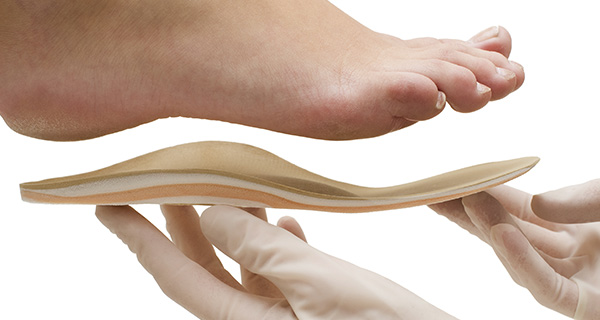
Can I Get Extra Pairs of Orthoses?
In most cases the image of your foot is stored on the computer at the laboratories. If you should want a specialized pair, or just an extra pair for convenience, it is easy to order your new devices. Specialized orthoses may include:
- Orthotic sandals,
- Dress shoe orthoses,
- Ski boot orthoses,
- Skate orthoses,
- Diabetic orthoses.
We always ensure the first pair is comfortable and functioning correctly before ordering additional pairs. Keep in mind since much of the work has already been done, additional pairs are much less expensive than the first pair.
Understanding cause of foot conditions and its mechanics is key to producing a successful medical device to treat foot and gait problems. Dr. Wang has extensive training in biomechanics and sports medicine. If you would like to obtain a pair of custom orthotics, contact us for an appointment today.

